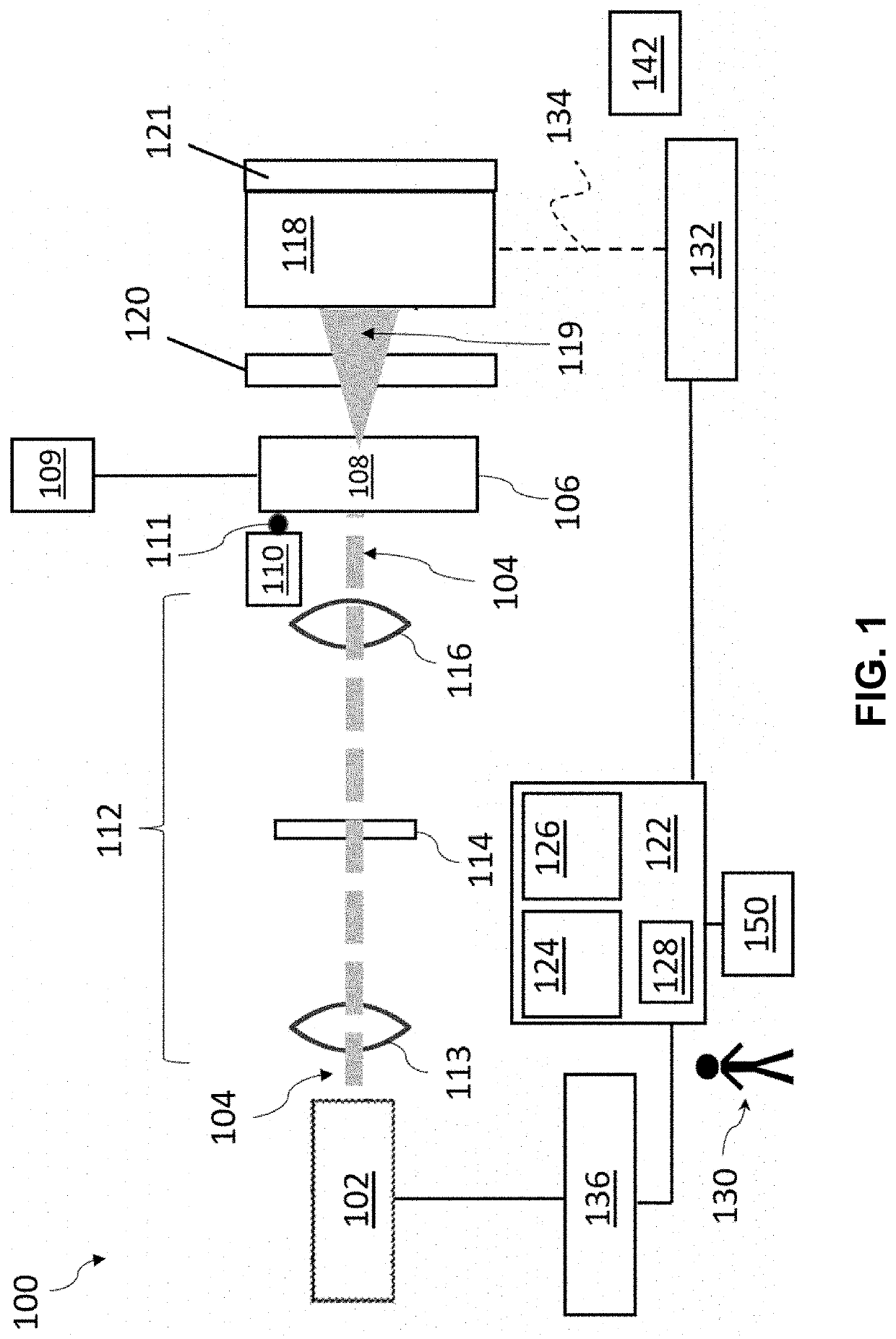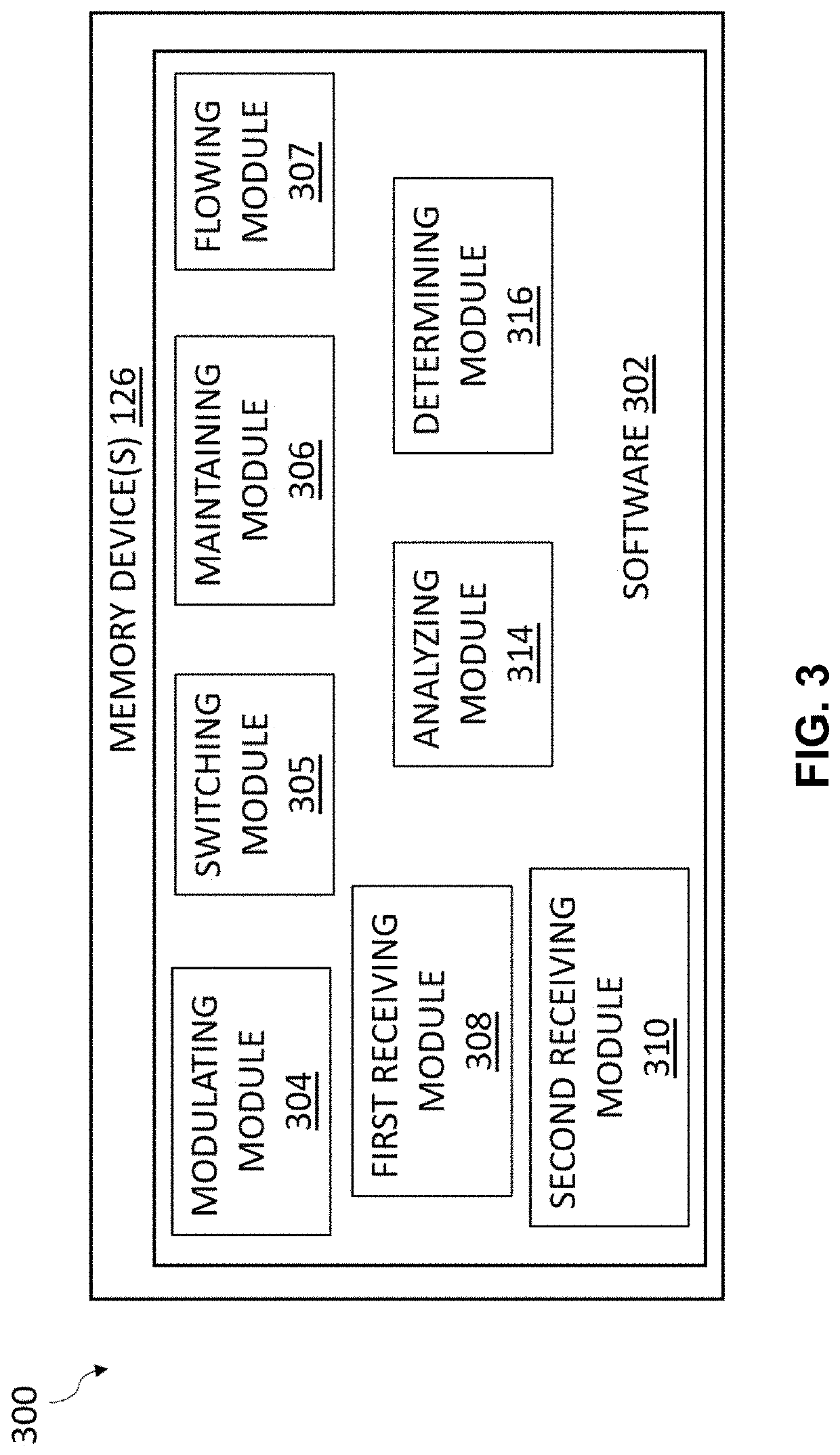Calibration verification for optical particle analyzers
a technology calibration verification, which is applied in the field of optical particle analyzer calibration verification, can solve the problems of difficult calibration process, high cost, and long total sampling time of over an hour, and achieve the effect of increasing the probability of an instrument being successfully tested and sensitive and accura
- Summary
- Abstract
- Description
- Claims
- Application Information
AI Technical Summary
Benefits of technology
Problems solved by technology
Method used
Image
Examples
example 1
[0123]Check Pulses Effectiveness Investigation
[0124]An IsoAir®-310P instrument equipped with the laser as the source of EMR 102 (30 mW laser power) was used as a test instrument to perform the following experiments in Example 1 to determine what percentage of post-Bessel filter laser-on pulse is derived from light collection mirrors and what percentage is derived from a source other than the mirrors.
[0125]FIGS. 7A-7C are plots of detector signal waveforms for Example 1 of the disclosure. The plots shown in FIGS. 7A-7C depict detector signal waveforms for three laser-on pulses with mirrors (2.0Vp). As shown by the plots of FIGS. 7A-7C, the three measured laser power-up pulses indicate a stable and repeatable peak value of 2.0 Vdc and a laser power-up event rise-time of approximately 1.25 ms.
[0126]FIGS. 8A-8C are plots of detector signal waveforms for Example 1 of the disclosure. The plots shown in FIGS. 8A-8C depict detector signal waveforms for three laser-on pulses with black paint...
example 2
[0130]Study of Allowed LASAIR-IV Signal Loss to Maintain Passing as-Found Calibration Results
[0131]Example 2 was a study of a manufacturing cell calibration program data-base typical first channel size resolution results calculated for each instrument model type (Particle Measuring Systems, Inc.). Minimum ISO-21501-4 allowed size error was determined from sizing and counting efficiency as-found test limits. Gaussian distribution sizing distribution size error was then converted to amplitude error by applying the LASAIR-III theoretical sizing calculations. The final result was calculated to represent the maximum amount of particle signal loss that could be observed while the instrument would theoretically pass the as-found calibration requirements of ISO-21501-4.
[0132]Summary table of Example 2 study results:
[0133]
First30%30%CH# of10%C.E.C.E.FirstSizeUnitsSizeSizeSizeAmplitudeInstCHResinErrorErrorErrorErrorModelSizeStudyStudyLimitLimitLimitLimit310C0.3um7.4%147730nm12.1nm4.0%20.2%310...
example 3
[0136]Description of Detector Board Low Speed, Check Pulses, Peak and Hold ADC Circuit
[0137]FIG. 11 is a schematic diagram (LT-Spice) of a frequency-tuned closed loop peak and hold circuit with reset 1900 in accordance with an embodiment of the disclosure.
[0138]Stage 1 of circuit 1900: Voltage gain amplifier with bandwidth limiting (Q=4.0). Allows gain scaling and low pass filtering of check pulses signal. Signal originated from the high gain Bessel filter output. Primary components: (1 stage) AD8034 FET op amp, + / −12Vdc PS.
[0139]Stages 2 & 3 of circuit 1900: Classical closed-loop peak-and-hold circuit, with reset feature. Primary components: (2 stages) AD8034 FET op amp, (1) PMEG3002AEB Schottky Barrier diode, hold charge capacitor, isolation resistor to buffer first amp output from charge capacitor, ADG1402 and ADG1401 CMOS SPST peak-and-hold reset switches, SN65LVDS2DBVR differential line receiver to drive reset switches from main PCB, isolation resistor to buffer switch from cha...
PUM
| Property | Measurement | Unit |
|---|---|---|
| time | aaaaa | aaaaa |
| wavelengths | aaaaa | aaaaa |
| wavelengths | aaaaa | aaaaa |
Abstract
Description
Claims
Application Information
 Login to View More
Login to View More - R&D
- Intellectual Property
- Life Sciences
- Materials
- Tech Scout
- Unparalleled Data Quality
- Higher Quality Content
- 60% Fewer Hallucinations
Browse by: Latest US Patents, China's latest patents, Technical Efficacy Thesaurus, Application Domain, Technology Topic, Popular Technical Reports.
© 2025 PatSnap. All rights reserved.Legal|Privacy policy|Modern Slavery Act Transparency Statement|Sitemap|About US| Contact US: help@patsnap.com



